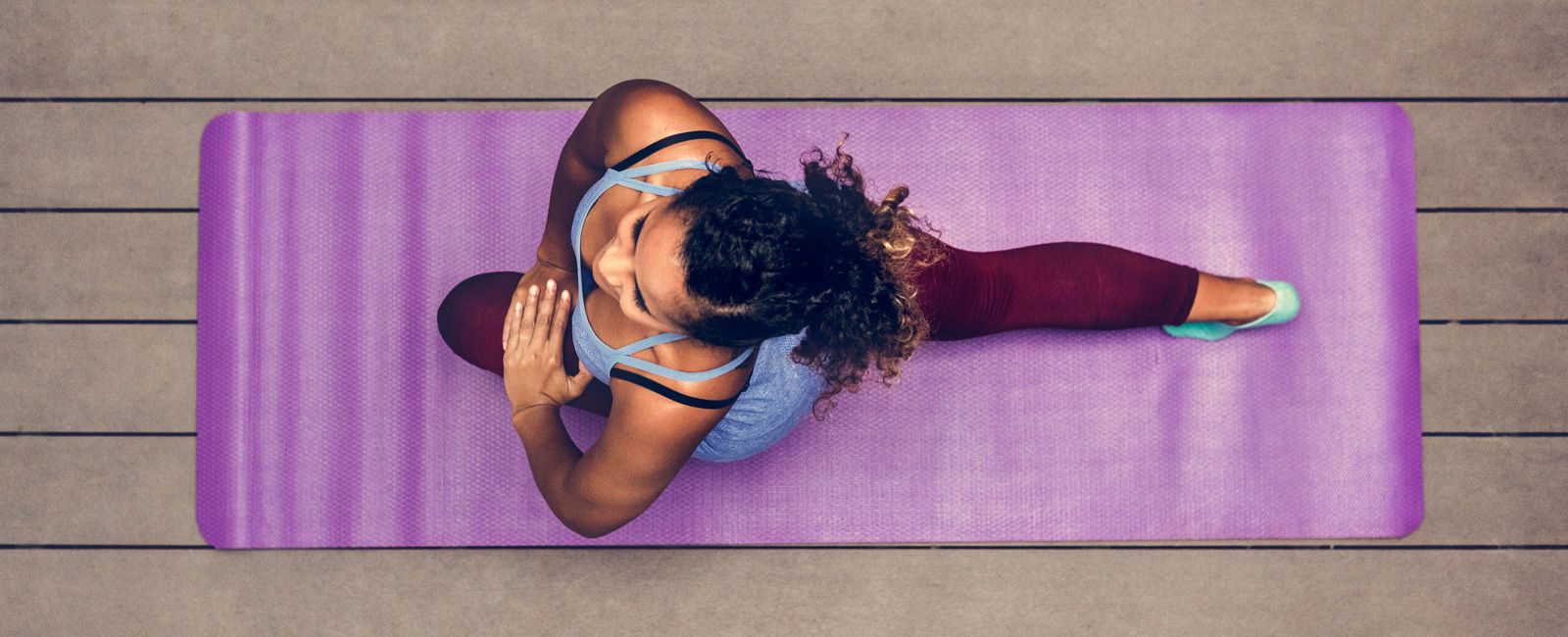YOGA
IT'S NOT ABOUT TOUCHING YOUR TOES,
IT'S ABOUT WHAT YOU LEARN ON THE WAY DOWN
Hatha Yoga

Yoga & Its Benefits
-
Builds immunity. When you contract and stretch your muscles, move your organs around and come in and out of yoga postures, you increase the drainage of lymph. This helps the lymphatic system fight infection and dispose of the toxic waste products of cellular functioning.
-
Yoga relaxes the mind and releases tension in the body when you focus on your breath, especially the pranayama (breath) part of your yoga practice.
-
Tones your spine/back health. All of our nerves branch out from the spine (where all your lovely Chakras live but that's another article altogether), connecting the various organ systems to the brain. It is said that if the spine is rigid, nerve impulses can't flow freely through the body and internal organs become weakened and subject to disease. If you keep the spine supple, the nerves remain strong and your health is maintained.
Modified Hatha yoga poses are an effective way to treat the symptoms of low back pain, and prevent disability associated with this condition. A review of the research in the Journal of Orthopaedic Rheumatology published in 2016 concluded that Hatha yoga can be as effective as other non-drug treatments in treating low-back pain and may actually be better than usual care methods.
-
Yoga isn’t just beneficial for improving core strength, flexibility, and stress levels; it can also help you sleep better - especially if you suffer from insomnia. When people who have insomnia perform yoga on a daily basis, they sleep for longer, fall asleep faster, and return to sleep more quickly if they wake up in the middle of the night. This is also true for older people who have insomnia —those who are 60 and older experience better sleep quality, sleep for longer, and feel better during the day when they perform regular yoga.
This benefit can be seen in all sorts of situations where people have trouble sleeping. For example, pregnant women who start a mindful yoga practice in their second trimester sleep better and wake up less often throughout the night, and cancer patients sleep better if they do yoga (90 percent of cancer patients experience insomnia symptoms while receiving treatment).
If you want to work yoga into your bedtime routine, it’s important to do the right kind of asanas as some of them are energising and you don't want to practice those before bed! Here are three poses that are ideal for preparing your body for sleep: Balasana (Child's Pose), Uttanasana (Standing Forward Bend), Prasarita Padottanasana (Wide-Legged Standing Forward Bend), Janu Sirsasana (Head-of-the-Knee Pose) and finally Savasana (Corpse Pose).
-
Strengthens and tones your body. Yoga asanas (poses) are weight bearing, held for varying lengths of time and are repeated multiple times during a practice. It is a great option for functional fitness as it allows your body to be both strengthened and stretched in variopus positions.
-
You all know about this one, increased flexibility. There are two major schools of scientific thought on what actually most limits flexibility and what should be done to improve it. The first school focuses not on stretching muscle fiber itself but on increasing the elasticity of connective tissues (the cells that bind muscle fibers together, encapsulate them, and network them with other organs); the second addresses the "stretch reflex" and other functions of the autonomic (involuntary) nervous system. Yoga works on both. That’s why it’s such an effective method for increasing flexibility in a safe environment.
-
Bone-Density Building. Weight-bearing yoga poses (think Tree, Side Angle, Triangle and Warrior I, II and III), help reverse bone loss in people with osteoporosis and osteopenia. A study published in Topics in Geriatric Rehabilitation in 2016 showed that just 12 minutes of practice daily can build density in the spine and femur.
-
Joint Mobility. When you don't regularly work your joints to their full range of motion, they tend to stiffen up and limit your movement. Hatha yoga poses work your joints in multiple directions, thus improving your mobility and flexibility. A study in the Journal of Physical Therapy Sciences from 2015 found that just one 90-minute yoga session per week greatly improved mobility in the joints, especially the spine, of women aged 50 to 70 years.
-
Yoga postures to help detoxify your organs. Twists squeeze and stimulate the abdominal and digestive organs, thereby rinsing toxins from the body and forward bends actively compress the digestive organs, speeding up elimination and inversions help drain fluids from the feet and legs back toward the heart.
-
Hatha Yoga is a physical exercise that involves different body poses, breathing techniques, and meditation. The therapy may help with depression and your symptoms, such as difficulty concentrating or loss of energy. Find out more from Healthline.
-
Builds Core Strength. Many Hatha poses improve your core strength — that's the center of your body, consisting of the spine, abdominals and hips. A strong core keeps you functional and wards off injury; it also improves your performance in sports and fitness. Poses such as Boat, Plank and Downward-Facing Dog strengthen your external obliques; Chair and Warrior I target your buttocks; and Chair and the Half-Lift improve the strength in your paraspinals, which are the muscles surrounding your spine and assist when you twist and bend (which also aids organ detoxification).
-
Balance and Posture. Hatha yoga poses can improve your ability to know where you are in space — that's your balance and proprioception. Good balance keeps you from being clumsy and potentially falling and injuring yourself when you encounter a change in terrain - think lovely cobbles on Haworth mainstreet, or simply step on lego! You also stand taller and look more confident as balance and proprioception impact your posture.
-
A variety of yoga practices such as postures, meditation, breathing and relaxation techniques positively impact the main endocrine glands responsible for the release happy chemicals.
Dopamine - a hormone and neurotransmitter known as the reward and motivational system of the body. A vigorous hatha practice, the weight-bearing components that yoga creates, as well as relaxation techniques such as yoga nidra and meditation, can boost dopamine levels by increasing cardiorespiratory output.
Endorphins act as a communication channel between the brain and nervous system. They react to external stimuli and emotions as a way to manage fear, anxiety and worry, as well as happiness, joy and pleasure. They are known for creating a sense of euphoria and are effective in pain management. Scientific research acknowledges that those who practice yoga experience increased endorphin levels post practice, commonly known as the 'yoga high'.
Oxytocin. A hormone produced during sex, orgasm and intimacy, reproduction, childbirth and breastfeeding. Oxytocin is also present during wound healing and management of inflammation as well as emotions associated with reducing fear and increasing a sense of trust. The first study to identify the effects of yoga and oxytocin was published in 2013. It identified that students showed a significant increase in oxytocin levels as well as social bonding. This is perhaps why we are also drawn more to practising together in a yoga class rather than on our own.
Serotonin. A neurotransmitter that influences mood and behaviour. Low levels of serotonin are most commonly linked to fatigue, depression, anxiety, apathy, insomnia, feelings of worthlessness and unexplained sadness. A variety of studies have shown that consistent practice of yoga, meditation, prayer and relaxation increases serotonin levels significantly. This further supports the exceptionally powerful way yoga influences our mood and increases the need for wellbeing. Yoga postures such as inversions and forward bends are therapeutic for the pineal gland and boosting melatonin levels, which is vital considering serotonin production is dependent on a minimum of seven continuous hours of sleep the previous night!
-
And so much more...

Amanda Meadows (Dip.Ayurveda)
Yoga Teacher | Ayurvedic Massage Therapist
Ayurvedic Lifestyle Consultant | Clinical Somatics Educator
Gomersal, West Yorkshire | amanda@pranadi.co.uk | Tel. 07411 548052